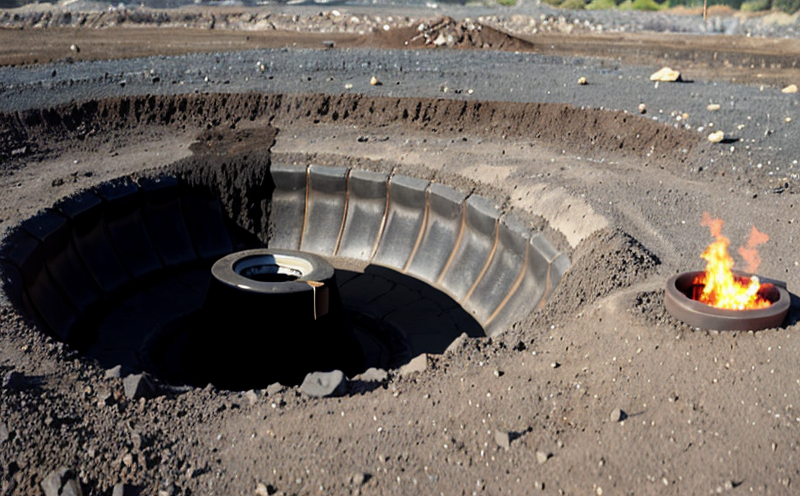DIN 51721 Volatile Matter in Coal Testing
The DIN 51721 test is a critical method used to determine the volatile matter content of coal, which plays a pivotal role in assessing its quality and suitability for various applications. Understanding volatile matter content is essential because it directly influences combustion efficiency, ash formation, and overall fuel performance.
Coal's volatile matter content refers to the percentage by mass of materials that will be lost during heating until no more gases are evolved. This test method specifies how to determine this value accurately through a controlled heating process in an oxygen-free environment.
The DIN 51721 procedure involves drying the coal sample at specific temperatures, followed by heating it under nitrogen or argon gas at around 900°C for a set duration. During this phase, volatile components like hydrocarbons and other combustible materials decompose into gases such as methane, carbon dioxide, and water vapor.
Accurate determination of volatile matter is crucial not only in quality control but also in optimizing coal utilization processes. This test helps industries like power generation, metallurgy, and chemical production to enhance efficiency while minimizing waste and emissions.
The test method has been widely accepted by international standards organizations such as ISO (International Organization for Standardization), ASTM (American Society for Testing and Materials), and EN (European Norms). Compliance with these standards ensures that the results are reliable, repeatable, and comparable across different laboratories globally.
In practice, this method is used in various stages of coal processing, from initial quality assessment to final product certification. Laboratories equipped with state-of-the-art equipment ensure precise measurements, which are vital for maintaining high-quality standards in the mining sector.
Understanding the volatile matter content also allows for better management of coal resources and helps predict potential issues related to storage and transportation. By knowing exactly how much volatile material is present, companies can optimize their supply chains and reduce costs associated with handling less efficient fuels.
Why Choose This Test
Selecting DIN 51721 for your coal testing needs offers several advantages. Firstly, it ensures uniformity in results across different facilities by providing standardized procedures and criteria. Secondly, adherence to this method enhances credibility within the industry, as it aligns with widely recognized international standards.
Secondly, compliance with DIN 51721 facilitates easier integration into larger quality management systems. Many organizations already have robust ISO or EN certifications; ensuring consistency in testing methods helps maintain these credentials without additional effort.
Thirdly, the accuracy and precision provided by this test contribute significantly to improving operational efficiency for mining operations. Knowing precisely what your coal contains allows better planning of production schedules, reducing downtime due to unexpected quality issues.
Finally, selecting DIN 51721 ensures that you are meeting regulatory requirements set forth by various governments and international bodies. This is particularly important in regions where environmental regulations are stringent or where there are specific safety guidelines for handling combustible materials like coal.
- Uniformity of Results: Ensures consistent outcomes regardless of the lab performing the tests.
- Credibility: Aligns with recognized international standards, enhancing your company's reputation.
- Operational Efficiency: Provides clear insights into coal quality, leading to optimized production schedules.
- Regulatory Compliance: Helps meet government and industry regulations more effectively.
International Acceptance and Recognition
The DIN 51721 method has gained international recognition due to its rigorous standards and consistent results. It is one of the most trusted methods for determining volatile matter content in coal globally.
Many countries have adopted this standard as part of their national testing protocols, ensuring that all involved parties are working from a common framework. This consistency is particularly beneficial when dealing with international trade agreements or collaborative research projects involving multiple nations.
The method's acceptance extends beyond individual laboratories; it has been incorporated into broader frameworks such as ISO and EN standards. These organizations endorse DIN 51721 because of its reliability and effectiveness in providing accurate measurements.
For instance, ISO/IEC 17025 specifies the requirements for competence of testing and calibration laboratories, which often includes compliance with specific test methods like DIN 51721. Similarly, EN standards frequently recommend or require this method when assessing coal quality.
Incorporating DIN 51721 into your testing protocols not only enhances the reliability of your results but also positions you at the forefront of industry best practices. By adhering to such widely accepted methods, you demonstrate a commitment to excellence and transparency in your operations.
Competitive Advantage and Market Impact
- Informed Decision Making: Provides precise data that enables better decision-making regarding coal procurement, processing, and utilization.
- Enhanced Product Quality: Ensures consistent product quality, which is crucial for maintaining customer satisfaction and loyalty.
- Cost Efficiency: By optimizing processes based on accurate test results, companies can reduce waste and improve operational efficiency.
The ability to accurately measure volatile matter content gives coal producers a significant edge in the competitive market. Consumers of coal products rely heavily on these tests to ensure they are receiving high-quality materials that meet their specific requirements.
For power generation plants, accurate knowledge of volatile matter helps optimize combustion processes, leading to reduced fuel costs and lower emissions. In metallurgical applications, understanding the volatile content can help improve steel-making efficiency, resulting in higher quality outputs and increased profitability.
In addition, compliance with international standards like DIN 51721 opens up new market opportunities domestically and internationally. Companies that demonstrate their commitment to stringent testing protocols are more likely to attract customers seeking reliable, high-quality coal products.
Moreover, the use of this method can contribute positively towards sustainability initiatives by helping reduce waste and promoting efficient resource utilization. This aligns well with growing global efforts to combat climate change through improved industrial practices.





